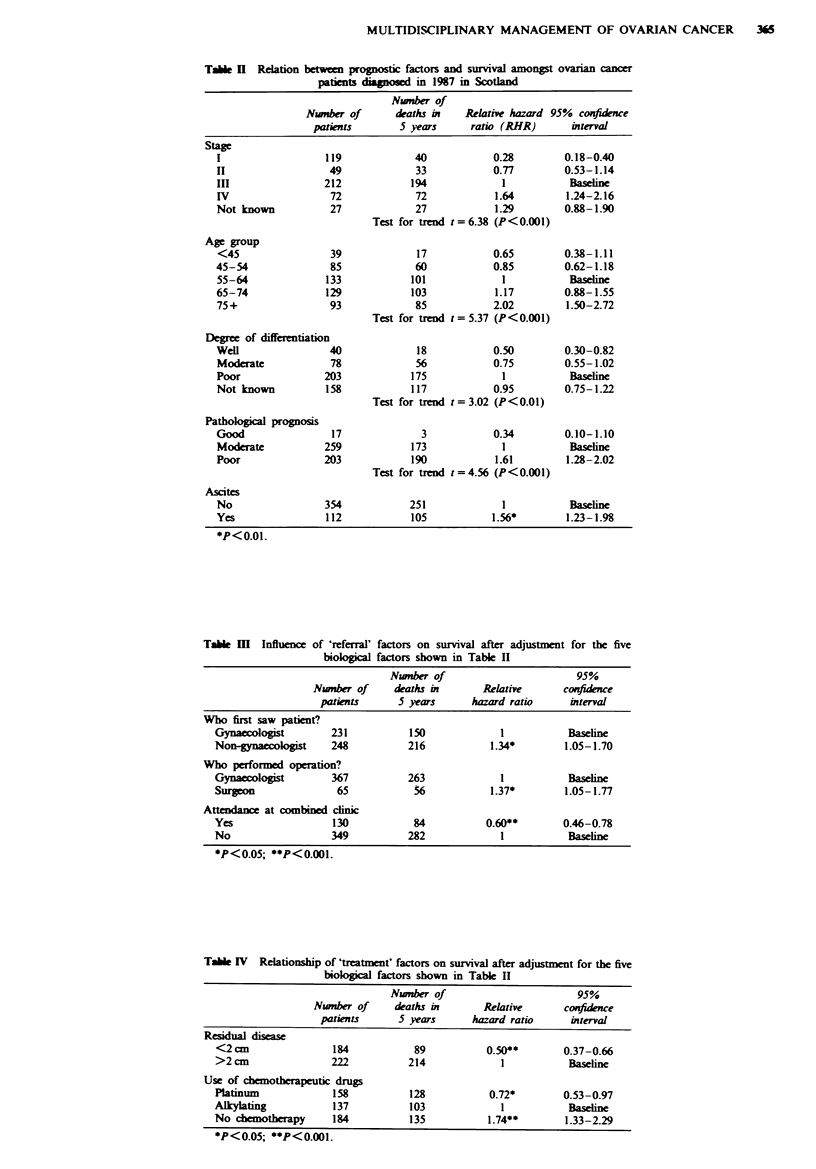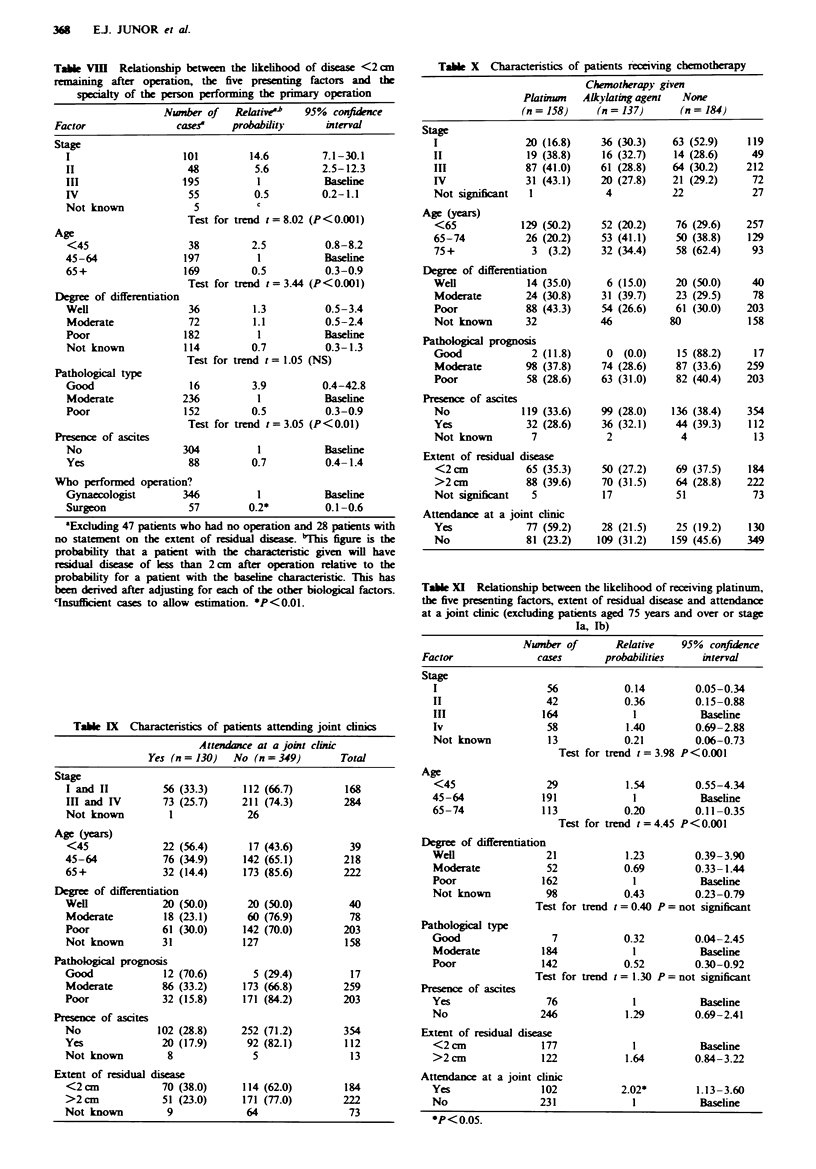Abstract
Differences in survival outcome for patients with ovarian cancer in Scotland led to an investigation of whether these differences were due to variation in presenting prognostic features or to the organisation and delivery of cancer services. A retrospective study of all 533 cases of ovarian cancer registered in Scotland in 1987 was carried out. After adjustment for age, stage, pathology, degree of differentiation and presence of ascites, survival improved when patients (1) were first seen by a gynaecologist (P < 0.05); (2) were operated on by a gynaecologist (P < 0.05); (3) had residual disease of less than 2 cm post-operatively (P < 0.001); (4) were prescribed platinum chemotherapy (P < 0.05); and (5) were referred to a joint clinic (P < 0.001). When gynaecologists operated the likelihood of smaller residual disease increased (P < 0.001). The improved survival from management by a multidisciplinary team at a joint clinic was not solely due to the prescription of platinum chemotherapy. The results of this study support the contents of the 1991 Department of Health report on present acceptable practice in the management of ovarian cancer, circulated to gynaecologists and surgeons in Scotland in 1992. The new finding that in a common cancer management by a multidisciplinary team at a joint clinic directly affects survival requires urgent attention.
Full text
PDF







Selected References
These references are in PubMed. This may not be the complete list of references from this article.
- Balvert-Locht H. R., Coebergh J. W., Hop W. C., Brölmann H. A., Crommelin M., van Wijck D. J., Verhagen-Teulings M. T. Improved prognosis of ovarian cancer in The Netherlands during the period 1975-1985: a registry-based study. Gynecol Oncol. 1991 Jul;42(1):3–8. doi: 10.1016/0090-8258(91)90222-q. [DOI] [PubMed] [Google Scholar]
- Davis S., Wright P. W., Schulman S. F., Hill L. D., Pinkham R. D., Johnson L. P., Jones T. W., Kellogg H. B., Jr, Radke H. M., Sikkema W. W. Participants in prospective, randomized clinical trials for resected non-small cell lung cancer have improved survival compared with nonparticipants in such trials. Cancer. 1985 Oct 1;56(7):1710–1718. doi: 10.1002/1097-0142(19851001)56:7<1710::aid-cncr2820560741>3.0.co;2-t. [DOI] [PubMed] [Google Scholar]
- Gillis C. R., Hole D. J., Still R. M., Davis J., Kaye S. B. Medical audit, cancer registration, and survival in ovarian cancer. Lancet. 1991 Mar 9;337(8741):611–612. doi: 10.1016/0140-6736(91)91673-i. [DOI] [PubMed] [Google Scholar]
- Griffiths C. T. Surgical resection of tumor bulk in the primary treatment of ovarian carcinoma. Natl Cancer Inst Monogr. 1975 Oct;42:101–104. [PubMed] [Google Scholar]
- Harding M. J., Paul J., Gillis C. R., Kaye S. B. Management of malignant teratoma: does referral to a specialist unit matter? Lancet. 1993 Apr 17;341(8851):999–1002. doi: 10.1016/0140-6736(93)91082-w. [DOI] [PubMed] [Google Scholar]
- Hole D. J., Gillis C. R. Use of cancer registry data to evaluate the treatment of ovarian cancer on a hospital basis. Health Rep. 1993;5(1):117–119. [PubMed] [Google Scholar]
- Högberg T., Carstensen J., Simonsen E. Treatment results and prognostic factors in a population-based study of epithelial ovarian cancer. Gynecol Oncol. 1993 Jan;48(1):38–49. doi: 10.1006/gyno.1993.1007. [DOI] [PubMed] [Google Scholar]
- Karjalainen S. Geographical variation in cancer patient survival in Finland: chance, confounding, or effect of treatment? J Epidemiol Community Health. 1990 Sep;44(3):210–214. doi: 10.1136/jech.44.3.210. [DOI] [PMC free article] [PubMed] [Google Scholar]
- Karjalainen S., Palva I. Do treatment protocols improve end results? A study of survival of patients with multiple myeloma in Finland. BMJ. 1989 Oct 28;299(6707):1069–1072. doi: 10.1136/bmj.299.6707.1069. [DOI] [PMC free article] [PubMed] [Google Scholar]
- Lennox E. L., Draper G. J., Sanders B. M. Retinoblastoma: a study of natural history and prognosis of 268 cases. Br Med J. 1975 Sep 27;3(5986):731–734. doi: 10.1136/bmj.3.5986.731. [DOI] [PMC free article] [PubMed] [Google Scholar]
- Malkasian G. D., Jr, Decker D. G., Webb M. J. Histology of epithelial tumors of the ovary: clinical usefulness and prognostic significance of the histologic classification and grading. Semin Oncol. 1975 Sep;2(3):191–201. [PubMed] [Google Scholar]
- Omura G. A., Brady M. F., Homesley H. D., Yordan E., Major F. J., Buchsbaum H. J., Park R. C. Long-term follow-up and prognostic factor analysis in advanced ovarian carcinoma: the Gynecologic Oncology Group experience. J Clin Oncol. 1991 Jul;9(7):1138–1150. doi: 10.1200/JCO.1991.9.7.1138. [DOI] [PubMed] [Google Scholar]
- Stiller C. A. Centralisation of treatment and survival rates for cancer. Arch Dis Child. 1988 Jan;63(1):23–30. doi: 10.1136/adc.63.1.23. [DOI] [PMC free article] [PubMed] [Google Scholar]
- Stiller C. A., Draper G. J. Treatment centre size, entry to trials, and survival in acute lymphoblastic leukaemia. Arch Dis Child. 1989 May;64(5):657–661. doi: 10.1136/adc.64.5.657. [DOI] [PMC free article] [PubMed] [Google Scholar]
- Voest E. E., van Houwelingen J. C., Neijt J. P. A meta-analysis of prognostic factors in advanced ovarian cancer with median survival and overall survival (measured with the log (relative risk)) as main objectives. Eur J Cancer Clin Oncol. 1989 Apr;25(4):711–720. doi: 10.1016/0277-5379(89)90208-3. [DOI] [PubMed] [Google Scholar]


